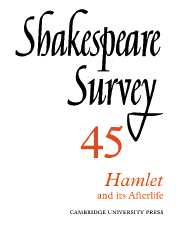Book contents
- Frontmatter
- The Reception of Hamlet
- ‘Hamlet, Revenge!’: The Uses and Abuses of Historical Criticism
- Revision by Excision: Rewriting Gertrude
- Gazing at Hamlet, or the Danish Cabaret
- ‘He’s Going to his Mother’s Closet’: Hamlet and Gertrude on Screen
- Shakespeare Rewound
- Freud’s Hamlet
- ‘Pray you, undo this button’: Implications of ‘Un-’ in King Lear
- Marx and Shakespeare
- Peter Street, 1553–1609: Builder of Playhouses
- Shakespeare Performances in England 1990–1
- Professional Shakespeare Productions in the British Isles, January–December 1990
- 1 Critical Studies
- 2 Shakespeare’s Life, Times, and Stage
- 3 Editions and Textual Studies
- Books Received
- Index
Peter Street, 1553–1609: Builder of Playhouses
Published online by Cambridge University Press: 28 March 2007
- Frontmatter
- The Reception of Hamlet
- ‘Hamlet, Revenge!’: The Uses and Abuses of Historical Criticism
- Revision by Excision: Rewriting Gertrude
- Gazing at Hamlet, or the Danish Cabaret
- ‘He’s Going to his Mother’s Closet’: Hamlet and Gertrude on Screen
- Shakespeare Rewound
- Freud’s Hamlet
- ‘Pray you, undo this button’: Implications of ‘Un-’ in King Lear
- Marx and Shakespeare
- Peter Street, 1553–1609: Builder of Playhouses
- Shakespeare Performances in England 1990–1
- Professional Shakespeare Productions in the British Isles, January–December 1990
- 1 Critical Studies
- 2 Shakespeare’s Life, Times, and Stage
- 3 Editions and Textual Studies
- Books Received
- Index
Summary
In the sixteenth century the City of London, on the north bank of the Thames, was compassed by a wall ‘on the land side, in forme of a bow’, in the words of John Stow’s Survey of 1598. Parts of the wall and the names of its great gates survive, and the modern street called London Wall runs alongside as it always did. At the heart of the City is its seat of government, Guildhall, and just to its east two streets – Basinghall and Coleman – still run north to London Wall. In the mid-sixteenth century this very small area was home for three families with names famous in Elizabethan stage history – Brayne, Burbage and Street.
Thomas Cromwell ordered parish registers to be kept in 1538, and the original paper books of St Michael Bassishaw and St Stephen Coleman Street survive from that date. 'Thomas Broyn and Alys Barlow', the future in-laws of James Burbage, builder of the Theatre in Shoreditch in 1576, were married at St Michael Bassishaw on 22 January 1540/1; and five years later, on 16 May 1546, John Street and Margaret Bullasse, the parents of Peter Street, builder of the Globe and Fortune, were married in the adjoining parish of St Stephen Coleman Street. The Braynes became parishioners of St Stephen's at some stage, and on 23 April 1559 James Burbage married their daughter Ellen — who cannot then have been more than seventeen years old — thus acquiring as brother-inlaw the man who was to become his partner, and later sparring-partner, in the Theatre enterprise.
- Type
- Chapter
- Information
- Shakespeare Survey , pp. 101 - 114Publisher: Cambridge University PressPrint publication year: 1992
- 2
- Cited by



